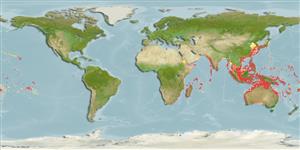Environment: milieu / climate zone / depth range / distribution range
Ecology
Marine; brackish; reef-associated; non-migratory; depth range 1 - 100 m (Ref. 9661), usually 1 - 50 m (Ref. 90102). Tropical; 42°N - 35°S, 18°E - 123°W
Indo-Pacific: Red Sea (Ref. 12541) and East Africa (Ref. 12484) to the Marquesan and Tuamoto islands, north to southern Japan, south to Lord Howe Island (Ref. 9710).
Size / Weight / Age
Maturity: Lm ? range ? - ? cm
Max length : 46.0 cm TL male/unsexed; (Ref. 3141); common length : 40.0 cm TL male/unsexed; (Ref. 9661)
Inhabit inshore on coastal muddy or sandy habitats in still bays, and commonly found in harbours and estuaries. Small juveniles on protected shallow mudflats (Ref. 48637). Found in weedy areas near rocks or reefs. Juveniles often near river mouths and in brackish water. Adults are solitary, juveniles often form small groups (Ref. 1602). Large adults are shy (Ref. 48637). Feed on benthic invertebrates by blowing away the sand (Ref. 1602). Readily dried and used to make ornaments (Ref. 12484).
Life cycle and mating behavior
Maturity | Reproduction | Spawning | Eggs | Fecundity | Larvae
Randall, J.E., G.R. Allen and R.C. Steene, 1990. Fishes of the Great Barrier Reef and Coral Sea. University of Hawaii Press, Honolulu, Hawaii. 506 p. (Ref. 2334)
IUCN Red List Status (Ref. 130435)
Threat to humans
Reports of ciguatera poisoning (Ref. 4690)
Human uses
Fisheries: of no interest; aquarium: commercial
More information
ReferencesAquacultureAquaculture profileStrainsGeneticsElectrophoresesHeritabilityDiseasesProcessingNutrientsMass conversion
Tools
Special reports
Download XML
Internet sources
Estimates based on models
Preferred temperature (Ref.
123201): 21.9 - 28.4, mean 27.2 °C (based on 532 cells).
Phylogenetic diversity index (Ref.
82804): PD
50 = 0.5625 [Uniqueness, from 0.5 = low to 2.0 = high].
Bayesian length-weight: a=0.02042 (0.01210 - 0.03446), b=2.77 (2.62 - 2.92), in cm total length, based on LWR estimates for this species & (Sub)family-body (Ref.
93245).
Trophic level (Ref.
69278): 3.5 ±0.37 se; based on food items.
Resilience (Ref.
120179): High, minimum population doubling time less than 15 months (Fec assumed to be > 10,000).
Fishing Vulnerability (Ref.
59153): Moderate vulnerability (36 of 100).
Nutrients (Ref.
124155): Calcium = 34.3 [14.7, 91.1] mg/100g; Iron = 0.579 [0.299, 1.289] mg/100g; Protein = 18.6 [16.4, 20.8] %; Omega3 = 0.126 [0.066, 0.240] g/100g; Selenium = 44.7 [22.1, 94.7] μg/100g; VitaminA = 36.7 [9.9, 143.1] μg/100g; Zinc = 1.13 [0.75, 1.68] mg/100g (wet weight);
